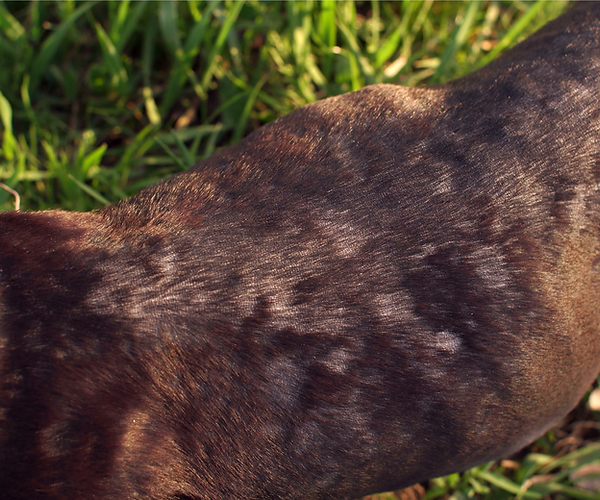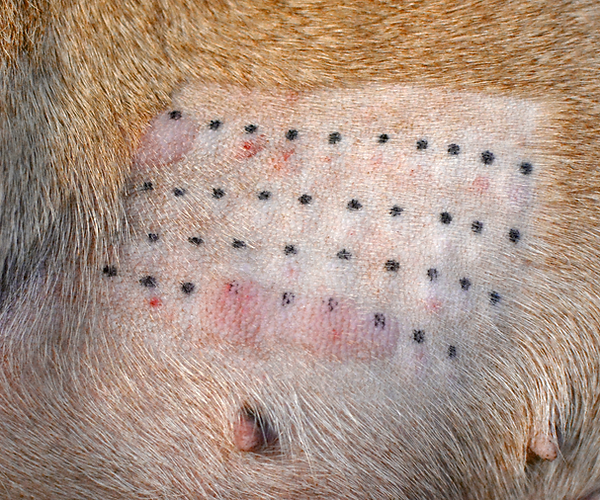
MiDOG technology can help determine if your dog’s allergies are actually an infection.
Watching your dog go through painful allergy testing is an awful experience. Tests like the intradermal skin test leave bright red and itchy wheals on their belly. What’s even worse than seeing your dog go through this painful diagnostic test is when results yield no allergic response to any substance tested.
Does Your Dog Really Have Allergies?
As it turns out, not every case in which dogs present itchy skin and excessive scratching is allergy-related. The three main causes of allergies in dogs are flea bites, atopic dermatitis, and food allergies. According to previous studies, only 6.82% of dogs have flea infestations, 10-15% have atopic dermatitis, and 1-2% have food allergies.[1-3] That means that the odds are high that the “allergy symptoms” your dog is experiencing could really be due to a skin infection. In those cases, the allergy test is pointless. If your dog is scratching excessively, it’s best to find out if your dog actually needs an allergy test or if a simple painless skin swab will do.
The Difference Between Allergies & Skin Infections in Dogs
Based on external symptoms alone, it can be difficult to differentiate between allergies and skin infections. An allergic response is the result of a hypersensitive immune response against a substance that is normally harmless to the body. It can cause inflammation and redness of the skin. The problem is that inflammation and redness are also very commonly seen in skin infections, but skin infections can be caused by bacteria or fungi.
There are some differences in terms of the symptoms that are possible for both allergies and skin infections, but they typically only present themselves in severe cases. On one hand, severe allergic reactions may cause your dog to go into anaphylactic shock, which is characterized by symptoms such as cold extremities, extreme exhaustion, diarrhea, or vomiting. On the other hand, severe skin infections might present pustules, skin abscesses, and oozing lesions.
While these types of symptoms are very distinct from each other, they are rare to see due to the severity the condition needs to have reached to make them appear. In most cases, telling allergies and skin infections apart in dogs can be almost impossible without the help of laboratory testing.
Common Dog Allergy & Skin Infection Symptoms
Many of the common symptoms seen in allergic responses are:
- Redness
- Inflammation
- Itchy skin
- Fur loss/patchy coat
- Licking
- Excessive Scratching

Dog with missing hair from skin allergies.
Why Dog Allergy & Skin Infection Symptoms Are Similar
Unfortunately, the list of allergy symptoms above is identical to the most observed skin infection symptoms. This similarity of symptoms is explained by the fact that your dog’s immune system responds in the same way to both allergens and infectious agents like bacteria, yeast, and fungi.
When an allergic response is triggered, it is because the immune system detects something it classifies as foreign and starts producing antibodies and hormones to help fight against the foreign invader. This is the correct response when fighting truly infectious agents like pathogens, but it is the same response when your dog’s immune system classifies pollen, or flea saliva, or any other number of non-pathogenic substances as foreign invaders.
The corresponding immune response is what leads to the symptoms seen for allergies, and that is why it is identical to skin infections. It is the same system of defense being applied in both cases which leads to the same symptoms.
Why Skin Swabs Should be Taken BEFORE Allergy Tests
If your dog starts presenting allergy symptoms, then it is possible that they do in fact have allergies and might need to be tested accordingly. The important thing to note is that the best way to help verify if your dog really needs an allergy test is to first perform a skin infection test.
Having your vet take a skin swab to test for common infections like Pyoderma and Staphylococcus pseudointermedius (commonly known as Staph) infections can help eliminate the possibility that the symptoms are being caused by bacterial or fungal overgrowth. If the skin swab shows no pathogens that are overly abundant in the region, that increases the odds that the symptoms are truly caused by an allergic response.

The aftermath of an intradermal allergy test.
An added benefit of a skin swab is that it is a very quick, non-invasive, and painless test compared to an intradermal allergy test. This means less stress, pain and discomfort for your dog compared to allergy tests. For these reasons, it is best to ask your vet to test for skin infections by swab analysis before jumping straight into allergy testing. In fact, treating your dog’s symptoms as allergies without prior testing for skin infections could potentially be dangerous if allergies are not the actual cause of the symptoms.
Treating Skin Infections as Allergies is Dangerous
If your dog is presenting “allergy” symptoms and is allergy tested before being checked for infections, there a risk that the allergy test itself could worsen your dog’s condition. When performing an intradermal allergy test, the various substances being tested as allergens are injected underneath the skin to see if their immune system will create a response in the form of swelling, redness or a rash around the injection area.
This puts pressure on the immune system to react to the foreign substances, and if your dog already has an underlying infection, this added pressure might overwhelm the immune system and make current infection symptoms worse. While there are many reasons why it is a good idea to screen for skin infections before allergy testing, there are also good reasons to regularly screen for skin infections even after allergies have been diagnosed as the cause of symptoms.
Routine Testing for Skin Infections Can Help Allergy Treatment
Let’s say your dog has been allergy tested, diagnosed with an allergy to pollen, and did not previously present with a skin infection. Unfortunately, this does not mean a skin infection will not develop in the future. In fact, dogs that are suffering from allergy symptoms or are being treated for allergies are more likely to develop skin infections.
One of the main reasons for this is that some allergy treatments may attempt to adjust your dog’s immune system to the allergen by injecting it in low doses as a vaccine. These immunotherapy treatments can cause milder forms of the same allergy symptoms and result in itchy skin.
When dogs are itchy either from allergic reactions or immunotherapy for allergies, they can scratch so much that they produce small breaks in the skin. Different infectious agents on the skin can then readily infect the area and produce infections like Pyoderma or a Staph infection alongside the existing allergies.
An immune system weakened from allergy tests or immunotherapy allergy treatment might be unable to defend effectively against a co-existing skin infection. This is a top reason for recurrent infections in dogs with allergies. Routine infection testing combined with a course of antibiotics targeting the infection can help eliminate the infection where the immune system alone could not succeed.
Risk Factors for Skin Infections
To help understand if your dog might be at risk for skin infections, here are some common skin infection risk factors that you can be on the lookout for:
Dog Skin Infection Risk Factors:
- Excessive scratching
- Warm, moist environments (i.e. wet fur after swimming)
- Wrinkly skin (often breed dependent)
- Being overweight (causes folds in the skin)
- Short-haired dogs (easier access of irritants to the skin)

An overweight dog with skin folds.
Ask Your Vet for This Test if You Suspect Allergies
Getting a skin infection test is a good preliminary measure before getting an allergy test, but not all skin infection tests are created equal. If your dog is experiencing allergy symptoms and you request a skin swab, you are most likely to have the swab analyzed by a cell culture growth test. This test typically takes 2-3 days, but depending on the type of bacteria can take up to 5 days to display results. Some fungal pathogens can even take up to weeks to grow. Additionally, research has shown that traditional culture tests can display only 1% of all the pathogens that are in the affected region.[4]
To help combat this problem, scientists at MiDOG LLC have developed a new type of test that uses Next-Gen Sequencing to provide an accurate picture of all the different pathogens infecting the area. In addition to being much more accurate than culture tests, the MiDOG test can even give information on whether the pathogens causing the infection are antibiotic-resistant! The test still uses the same quick and painless swab but can extract much more information.
For owners who want to ensure that their pet is best-taken care of, ask your vet if they offer the MiDOG test, or have it sent to your vet prior to your next visit. Allergy diagnoses can be complicated but ensuring that a good skin test narrows down the possibilities and helps monitor treatment can give your dog the best, most pain-free treatment available.
References:
[1]: Bond, R., et al. “Survey of Flea Infestation in Dogs and Cats in the United Kingdom during 2005.” Veterinary Record, vol. 160, no. 15, 2007, pp. 503–506., doi:10.1136/vr.160.15.503.
[2]: Hillier, Andrew, and Craig E Griffin. “The ACVD Task Force on Canine Atopic Dermatitis (I): Incidence and Prevalence.” Veterinary Immunology and Immunopathology, vol. 81, no. 3-4, 2001, pp. 147–151., doi:10.1016/s0165-2427(01)00296-3.
[3]: Olivry, Thierry, and Ralf S. Mueller. “Critically Appraised Topic on Adverse Food Reactions of Companion Animals (3): Prevalence of Cutaneous Adverse Food Reactions in Dogs and Cats.” BMC Veterinary Research, vol. 13, no. 1, 2016, doi:10.1186/s12917-017-0973-z.
[4]: Barcina, Isabel, and Inés Arana. “The Viable but Nonculturable Phenotype: a Crossroads in the Life-Cycle of Non-Differentiating Bacteria?” Reviews in Environmental Science and Bio/Technology, vol. 8, no. 3, 2009, pp. 245–255., doi:10.1007/s11157-009-9159-x.
Categories: Dogs, Skin Health


